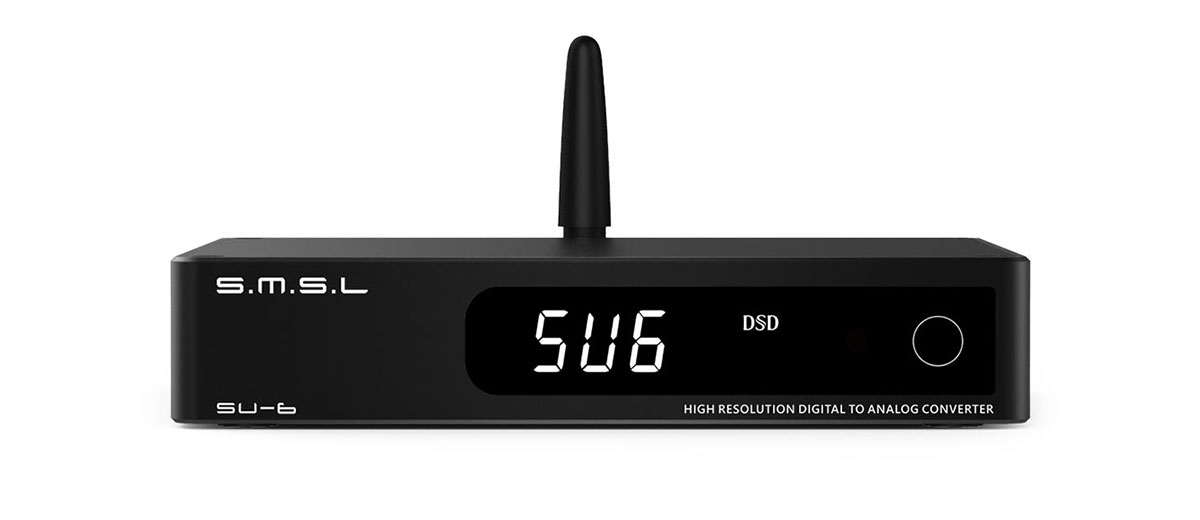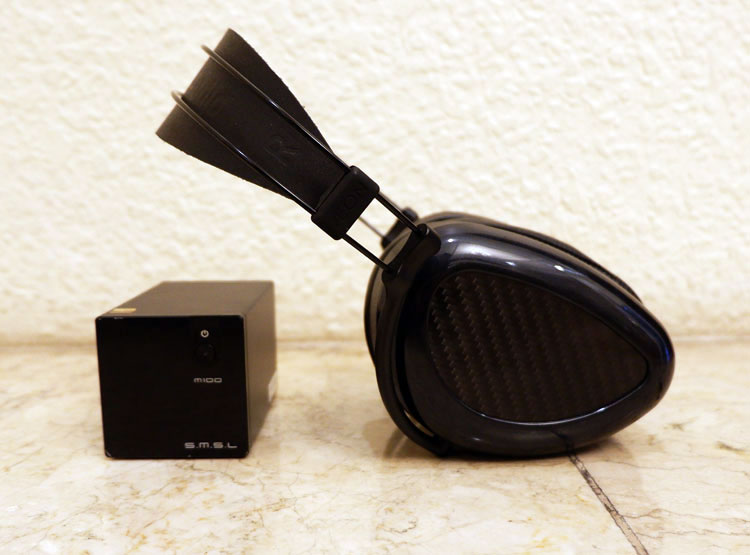Select Comparisons
SMSL M100 MKII
$93.99
Technical
Instead of using ESS’ range-topping ES 9038Q2M DAC, the M100 MKII utilizes the ES9018Q2C. However, this shouldn’t mean that the M100 MKII should immediately be counted out of the conversation. For its USB controller, the M100 MKII uses a similar 2nd generation XMOS USB controller chip, which allows it to decode PCM 32bit/768kHz, and DSD512.
Measurement results on the M100 MKII are also a step back, as it only has a measured THD+N of just 115dB, and a dynamic range of 121dB. I’d be interested to see how these measurements translate to real-world performance.
In terms of product features, the M100 MKII is also a step back from the SU-6, as it is designed as a simpler DAC. So, features like a Bluetooth connection option and a preamp option isn’t available. However, this results in the M100 MKII not requiring a power supply which may be of benefit to some.
Design
In terms of its footprint, the M100 MKII is much smaller, since SMSL opted to build vertically rather than horizontally. This may be a better option for someone who might be strapped for space on their desktops.
Aesthetically, the M100 MKII may seem a bit more playful in comparison, as it comes in a blue and black option with a blue LED display, instead of the more sleek black and silver options with a white LED display.
While the display on the M100 MKII is much smaller, and the button on the left is a tactile button instead of a touch-sensitive one, the controls on both DACs are similar, except that the M100 MKII doesn’t have an option for Bluetooth input.
The rear of the M100 MKII also looks similar, where there is even an option for an auxiliary power supply for when the other input options are used. However, the USB port on the M100 MKII is the more dated micro USB port, instead of a USB C port.
Performance
Despite coming from the same company, the two DACs have some significant sonic differences, particularly in terms of intensity.
The M100 MKII took the safer route, making it comparatively less intense while having a less prominent mid-bass region. This results in a more rounded low-end at the cost of some textures in the same region.
The vocal timbre on the M100 MKII tends to be brighter, thus allowing a more euphonic vocal presentation. However, the vocal textures are not as prominent while having an overall thinner midrange presentation. Although treble quantity is similar on both DACs, the M100 MKII is less intense, resulting in less edginess and shimmer.
There is a slight uptick in the upper treble range on the M100 MKII, which results in a wider soundstage presentation. However, the images that are formed within the soundstage aren’t as well defined while the space between the images isn’t as noticeable compared to the SU-6.
Topping D10s
$99
Technical
While the 2 DACs come from different companies, they share the same ESS ES9038Q2M DAC chip. Despite sharing the same DAC chip, the D10s is only limited to PCM 32bit/384kHz, and DSD 256 and is a comparatively simpler DAC, since it only allows for USB inputs, and nothing else. There are no options for Bluetooth or even optical and coaxial inputs.
Instead of having additional inputs though, the D10s can also be used as a USB to coaxial/optical converter, in addition to simply being a DAC.
Being a simpler build, the D10s is missing the option for adding in an external power supply. Therefore, it will rely on the power supplied by the upstream USB device, which may not be the cleanest source of power. This could be one of the reasons why the measured SNR on the D10s is a step back at 120dB.
Design
Although the D10s is narrower, it is deeper, which means that the two DACs have about the same footprint. However, the D10s has a more spaced-out backside, since it doesn’t require a power supply or even a Bluetooth antenna input.
Similarly, the front fascia is also simpler on the D10s, since there are no buttons or even input options. So the front of the device is dominated by a large screen with 3 7-segment display orange LEDs that show the sample rate of the file currently being decoded by the D10s.
Performance
Having the same DAC chip doesn’t equate to having a similar presentation, and these two DACs are another example of how that can be. The D10s has a comparatively more laid-back presentation, by having a more subdued mid-bass region, and a more recessed treble presentation.
Having a more relaxed bass presentation doesn’t mean that the D10s can’t present details in the bass region. In fact, the bass can be more textured while being less intense. However, the vocal textures on the D10s aren’t as prominent, making it a bit harder to pick out the nuances in vocalists such as Adele or Michael Buble.
Treble extension is more glossed over as well, making the D10s comparatively less excitable. Also, the timbre of wind instruments ends up being less accurate, making them sound smaller than they ought to be. Despite being airier, the soundstage ends up being comparatively more intimate while retaining a level of image separation.
Topping E30
$134
Technical
While there is some price discrepancy between the two DACs, the absence of a power supply inside the E30 package necessities the use of an external power supply, power bank, or an audiophile power supply like the ifi iPower 2. So I could see the total cost of ownership of both DACs to be about the same.
With most current production sources sporting DAC chips from ESS, the E30 still uses an AK4493 DAC chip, which allows the E30 to decode 32BIT/768kHz PCM and DSD512. The E30 has a measured SNR of 121dB, and a dynamic range of 119dB, which puts it a few dB below the measurements cited for the SU-6.
The input options on the two DACs are also pretty similar, as they both accept USB, Coaxial, and Optical, but the E30 doesn’t have an option for Bluetooth. The output on the two DACs is also similar, and both also have an option for volume control and some filter options.
Design
At first glance, the E30 might seem like the smaller DAC, but the E30 doesn’t have a built-in power supply which may add to the bulk of the E30.
The rear of the E30 is similar, except that it doesn’t have a Bluetooth antenna input. Also, the USB input port for the E30 is a full-sized USB B port, instead of a USB C port, which means that the E30 could use some better audiophile-grade USB cables.
Controlling the two DACs is also a very similar experience, with both having a touch-sensitive button on the front fascia. Then they also both have a remote control to go through the different functions of the device. I would just say that the E30 can be more distracting with the orange LED screen instead of a more subdued white LED screen.
Performance
Compared to the SU-6, the E30 has a more even-handed tonal balance with comparatively less intensity. This makes way for a more prominent midrange presentation while having less midbass bloom while maintaining the same level of control over the bass region. Making the low-end more relaxed sounding while having the same level of texture and extension.
The vocal timbre is a touch warmer, while midrange instruments have a less incisive character making guitars sound less crunchy and edgy. Treble has less of a tendency towards sibilance, but the edginess and shimmer on both DACs can be considered similar while the E30 maintains more composure with most passages.
Although the treble on the E30 extends well into the upper treble, there is less of an uptick making it less artificially airy. This results in a comparatively intimate soundstage presentation, however, the images are equally well defined and separated on both DACs.
Our Verdict
It’s interesting to see how SMSL has been pushing the boundaries of what can be done with so little, both in terms of price and physical dimensions.
When I first opened the box of the SU-6 I was surprised at how small the SU-6 is, but the diminutive size of this DAC shouldn’t be a basis of what it can do. In fact, I would say that it’s a great size for those who have limited desk real estate but are looking for great performance out of their system.
Although the sonic presentation of the SU-6 isn’t perfectly neutral, having a more energetic presentation can be a breath of fresh air. This allows the SU-6 to create an overall more engaging listening experience that draws you to the music even more. All this while being a full-featured DAC with Bluetooth and volume control in such a small package.
SMSL SU-6 DAC Specifications
- Inputs: 1x USB-C, 1x Optical Toslink, 1x Coaxial Bluetooth
- Output: 1x Stereo RCA
- DAC chip: ESS ES9038Q2M
- Bluetooth version 5.0
- Supported Bluetooth codecs SBC, AAC, aptX, aptX HD, LDAC
- USB Interface: XMOS
- Supported sampling rates USB : PCM up to 32bit 768kHz, DSD up to DSD512
- Optical / Coaxial : PCM up to 24bit 192kHz, DSD DoP up to DSD64
- USB Compatibility: Windows 7 / 8 / 8.1 / 10, Mac OSX, Linux
- USB Transmission: Asynchronous
- THD+N: 0.0001% (-120dB)
- Dynamic range: 125dB
- SNR: 125dB
- Output impedance: < 10Ω





